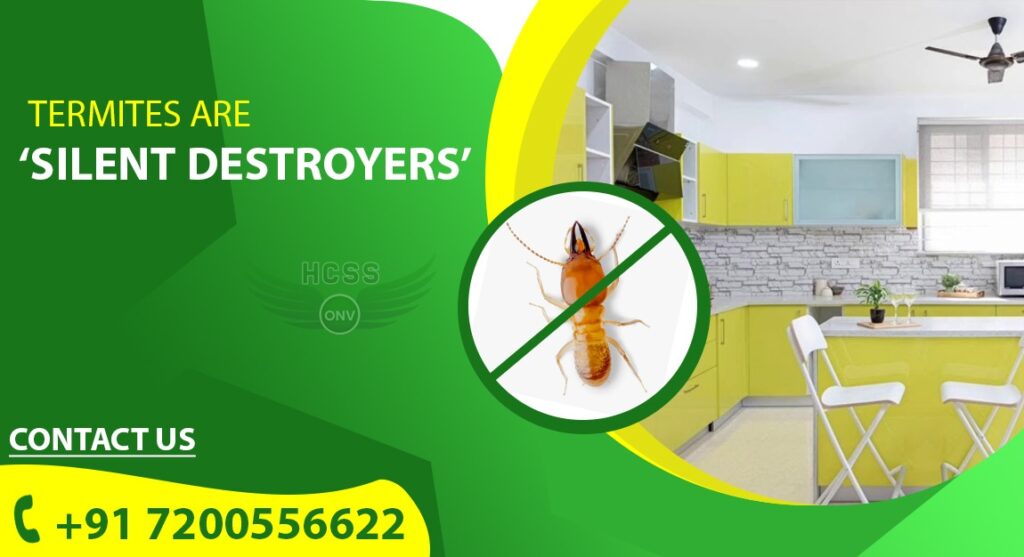Termites are silent destroyers. Are you concerning about termite attacks on your property? Schedule your free termite inspection today!
Our professional Termite Control Service in R.A Puram knows how to check for termites and can provide a strategy to help remove infestations and keep termites away from your property.
Termites:
Termites are tiny creatures that live in large groups which mostly feed anything made up of cellulose such as dead wood, live wood, paper &, paper products, wooden furniture & furnishings, and clothing, etc.
Termites love to expand their colony in an environment with moisture, darkness, and nourishment. It builds colonies in the soil and usually works its way above ground to reach wood and eat. Over time, termite damage can become significant on door frames, kitchen cabinets, staircase, and wooden flooring. They do this silently and swiftly, even before you become aware of the damage done.
Most common type of termites:
1. Subterranean Termites
- Subterranean termites are the most common species found in home infestations. This termite belongs to the family Rhinotermitidae and typically lives in the soil and builds the largest nests. These nests are connected via mud tubes to food sources, such as trees, fence posts and structural timbers in houses.
- Signs of a subterranean termite infestation include active swarmers, discarded wings, the presence of mud tubes, and damaged wood that appears soft, sounds hollow, or appears rippled, peeling, or bubbled.
2. Drywood Termites
- Drywood Termites belong to the family Kalotermitidae and typically live in wood, such as dead trees, structural timbers or hardwood floors. Drywood termites do not require contact with soil and don’t produce mud tube. Their colonies are smaller than subterranean termite colonies.
- Signs of drywood termite infestation include dead swarmers, discarded wings, and appearance of frass (hexagonal fecal pellets that pile up under the wood they infest).
3. Dampwood Termites
- Dampwood Termites belong to the families family Kalotermitidae and Hodotermitidae and typically live in wood with high moisture content. Most dampwood termites do not require contact with the soil.
- Dampwood termites are rarely found in homes or other man-made structures, since wood in these structures typically does not have enough moisture.
Sources of Termites:
- Moisture: Leaky pipes, improper drainage, and poor airflow all create moisture issues that attract termites.
- Wood that’s in Contact with House Foundations: Wood touching the foundation of homes makes those buildings susceptible to infestation. Mulch, overgrown shrubs, and firewood placed too close to homes are just some types of wood that grant termites access to structural wood.
- Cracks in Building Exteriors: Any crack or fissure in home foundations or gaps in siding, cracks around windows and doors offer termites the opportunity to come inside and start colonies.
Signs of Termite infestation:
- Swarmers (winged flying termites)
Swarmers are usually one of the first signs of a termite infestation. Swarmers are winged termites that emerge from nests in large groups. Any sign of a swarm is an indication of an existing colony and soon to form a new colony.
- Piles of Discarded Wings
Discarded wings are another visible sign of a termite infestation. You may find piles of wings left behind after swarms (often resembling fish scales) around the foundation of the property they are infesting.
- Mounds of Termite Droppings
Termite Droppings or fecal pellets are key signs of termites, particularly drywood termites. You may find mounds of fecal pellets known as frass (often resembling small piles of sawdust or coffee grounds, pepper, sand, and salt) around the area they are infesting.
- Mud tubes
Mud tubes are the most common sign of subterranean termite activity which is made of soil and termite droppings, to provide moisture and connect them to their food source. You may find these mud tubes near the foundation of the building.
- Patterns in furnitures, floors or walls that look like mazes.
- Head banging or chewing noises
Quiet clicking sounds coming from the walls are another sign of termites. Soldier termites bang their heads against the wood or shake their bodies in order to signal the other termites in the colony when they feel threatened or sense danger.
Damages caused by Termites:
- Hollowed wood/ Crumbled wood
Hollowed wood can also be a sign of termite activity. Termites eat wood from the inside out, leaving the center of a piece of wood hollow. Damaged wood will sound hollow or papery when tapped.
- Blistering of wood
Dark areas or blisters in wood flooring can indicate termites feeding within or below.
- Sagging or squeaky floor boards
- Stuck windows or doors
Stiff windows and warped doors can also mean termites. The moisture they produce when eating and tunnelling through door and window frames causes the wood to warp, making it tough to open doors and windows.
- Loose tiles
Tiles loosening from the added moisture termites can introduce to your floor.
- Discoloured drywall and peeling paint that resembles water damage.
- Small, pinpoint holes in drywall.
How to prevent termite infestation?
Practices that help to prevent termites infestation include:
- Get rid of excess moisture
- Maintain a Distance between Soil and Wood
- Fix Leaks & seal gaps caused by settling
- Remove food sources
- Keep plants away from your home
- Keep flying termites away during swarming season
- Use Borate on Wood before Priming or Painting
- Get regular termite inspections
Termite Control Service in R.A Puram:
Our Termite Control Service in R.A Puram professionals can be expected to:
- Initial inspection with the latest equipments and tools.
- Confirm the infestation.
- Propose detailed treatment plan.
- Complete treatment plan.
- Discuss service agreement provisions such as re-treatment (s), damage repair or replacement, and guarantees.
- Continue service agreement or warranty.

